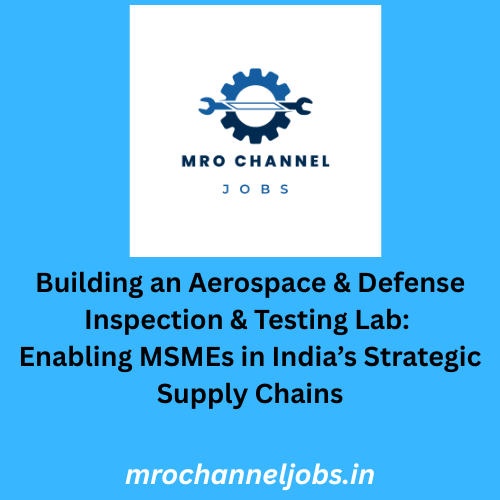Introduction
India’s ambitions in aerospace and defense (A&D) manufacturing hinge not only on large primes but also on the active participation of MSMEs. For smaller players, compliance with stringent global quality standards remains a key hurdle. A dedicated, multi-disciplinary Aerospace & Defense Inspection and Testing Lab can bridge this gap, empowering MSMEs to deliver world-class components, strengthen indigenisation, and qualify for international supply chains.
1. Governance & Accreditation
Any credible testing facility must be governed by robust accreditation frameworks to ensure impartiality, traceability, and global acceptance.
- Certification Standards: AS9100 (Aerospace Quality Management), ISO/IEC 17025 (Testing & Calibration), NADCAP (special processes like NDT, coatings, welding), and DGCA/DGQA/DRDO certifications for India-specific defense compliance.
- Ownership Models: Government-backed, industry-led, or MSME-cluster based, ensuring shared access while maintaining independence.
2. Core Functional Divisions
A modern A&D inspection and testing lab should house specialized divisions covering the full spectrum of materials, processes, and environmental stresses:
- Mechanical Testing – tensile, fatigue, hardness, creep testing for alloys.
- Non-Destructive Testing (NDT) – UT, RT, MPT, DPI, ECT under ASNT/ISO 9712 standards.
- Metallurgical & Chemical Analysis – SEM, XRF, corrosion resistance, hydrogen embrittlement.
- Environmental & Climatic Testing – vibration, shock, salt fog, altitude simulation.
- Calibration & Dimensional Metrology – CMM, laser interferometers, torque/pressure calibration.
3. Human Resources: Technical Trades Required
To operate such a lab, a pipeline of specialized trades and technicians is essential:
- Mechanical & Material Testing: Mechanical Testing Technician, Specimen Prep Technician, Metallurgy Technician.
- NDT Specialists: UT, RT, MT, PT, ET Operators (Level II certified under Level III supervision).
- Metallurgy & Chemical Analysis: Metallography Technicians, Spectroscopy Operators, Coatings Specialists.
- Environmental Testing: Vibration & Climatic Test Technicians.
- Calibration & Precision Measurement: Dimensional Metrology, Calibration, Surface Measurement Technicians.
- Avionics & Electronics: PCB/Connector Inspectors, Avionics Test Technicians, Cleanroom Operators.
- Safety & Digital Support: Radiation Safety Officers, EHS Technicians, Lab IT Operators.
4. Trade-to-Institute Mapping
A sustainable manpower pipeline can be created by aligning trades with India’s existing training ecosystem:
- ITI Courses: Fitter, Machinist, Welding, Electronics Mechanic, Instrument Mechanic, COPA (for Lab IT).
- Polytechnics & Diplomas: Mechanical, Metallurgy, Electronics, Avionics Engineering.
- Specialized Training:
- BARC – Radiation safety & NDT.
- National Certification Board (NCB-NDT), DGCA-approved centers – NDT Level II/III.
- CSIR-NML, DRDO, HAL, BEL – Metallurgy, Avionics, Calibration.
- NABL-accredited Tool Rooms (CITD, IGTRs) – Metrology & calibration.
- BARC – Radiation safety & NDT.
Government programs like NSDC’s Aerospace & Aviation Sector Skill Council (AASSC) and PMKVY can subsidize training, while defense PSUs and DRDO can provide apprenticeships.
5. Support Infrastructure
Beyond testing equipment, the lab should integrate:
- Digital Lab Management Systems (LIMS) – Blockchain-ready traceability for global supply chains.
- Clean Rooms & Controlled Environments – For avionics and composites.
- Knowledge Transfer Programs – Linking ITIs, engineering colleges, and MSMEs.
- Specimen Preparation Facility – Cutting, polishing, etching equipment.
6. Compliance & Reporting
- Test reports with traceable calibration certificates.
- Long-term archiving (10–15 years) per defense contract norms.
- Secure digital portals for MSMEs and OEMs to access results.
7. Strategic Role in the Ecosystem
An A&D testing lab is not just infrastructure—it is an enabler of industrial growth:
- For MSMEs: Shared access reduces compliance cost and opens pathways to supply Airbus, Boeing, HAL, BEL.
- For Export Enablement: ISO/NADCAP-certified reports ensure international acceptability.
- For GCCs & R&D Centers: Supports validation and simulation with real-world test data.
- For Defense Offsets: Serves as a qualifying body for foreign OEMs sourcing from India.
The Way Forward
Establishing such cluster-based, accredited inspection and testing labs will transform the ability of MSMEs to participate in aerospace and defense supply chains. By combining global certifications, modern testing capabilities, and a skilled workforce pipeline sourced from ITIs, polytechnics, and specialized institutes, India can:
- Reduce dependence on foreign testing houses.
- Lower costs for MSMEs while maintaining international compliance.
- Accelerate indigenisation under Atmanirbhar Bharat.
- Position Indian MSMEs as credible suppliers in global aerospace and defense programs.
✅ In essence, a national network of aerospace & defense testing labs, anchored in MSME clusters, is a strategic necessity to build sovereign capability and global competitiveness in high-technology manufacturing.



